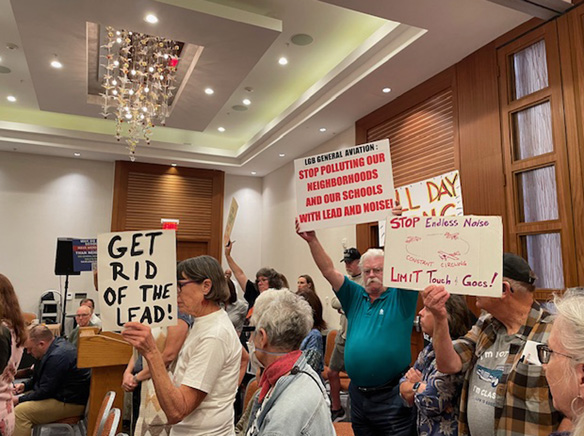
Hope for mitigating worsening noise pollution from general aviation activity likely requires reimagining more than just one local noise ordinance.
Residents living in neighborhoods surrounding Long Beach Airport are mobilizing to protest the persistent noise from piston engine aircraft flying in low circles above their homes from 7am until around midnight. The bulk of the dialogues between city council, airport administrators, and community members centers on the quantity of training school operations and city staff’s authority to regulate them. While the quantity of planes overhead heavily contributes, several other variables also influence a person’s perception of noise. In the modern aviation landscape, these variables appear more pronounced than they did before.
The ongoing pilot shortage is principally blamed for the dramatic increase in flight school activity at airports nationwide. Southern California’s airspace is enviable, resulting in a crowding of these flight schools in the area, including at Long Beach Airport (LGB).
These circumstances account for the rise in general aviation activity – a grouping that includes flight schools that use piston engine aircraft – at LGB since 2018. However, records indicate this category of activity is actually less today than it was in the 1990s, according to the FAA Air Traffic Activity System. Still, residents insist their experience of noise emitted from the airport has never been worse.
Co-founder of the Long Beach-based Small Aircraft Noise Reduction (SANeR) activist group, John Mosquera, compared the noise from piston engine aircraft to a “lawnmower or leaf blower going off around your home all day. It’s okay a couple flights an hour, but not incessant.” He said the “harmonics of the air beating” and “chopping in the air” has heightened his anxiety and made it impossible to enjoy sitting in his yard.
SANeR’s other co-founder, Lisa Dunn, said her anxiety has also increased. She runs her TV and fans all day. She installed fountains in her backyard to muffle the noise.
Bella, a California Heights homeschool student wears noise cancelling headphones to bed because of the ongoing noise. She said she is drained and it is hard to get through a day. Her dad Duane said he knew to expect noise living so close to the airport, but he could never have anticipated it would be to this degree. Other residents feel the same.
When Nora Carter, a student at Longfellow, is outside at school, her friends cannot hear her. At a neighboring elementary school, a teacher said the noise from the piston engine aircraft is so loud it interrupts PE teachers’ instruction.
Nora’s mom Julie is continually interrupted during work and her mental health has noticeably declined. “I feel like I’m going insane.” While some residents are considering selling their homes if noise does not lessen in the next couple years, Julie and her husband Chris agree it does not make financial sense for them to move.
As of August 1, 855 residents had joined SANeR’s Facebook group to lobby for a reduction in the airport’s noise emission. They represent California Heights, Bixby Knolls, Los Cerritos, Los Altos, El Dorado Park, Memorial Heights, Signal Hill, and Lakewood. Dunn and Mosquera encourage members to give comment at city council and airport administration meetings, email representatives weekly, and not be shy to upload noise complaints online. The group has also distributed lawn signs and fliers to neighbors to educate, grow, and galvanize.
Researchers at the BU School of Public Health and OSU found that “airplane noise may increase one’s risk of developing cardiometabolic diseases, a cluster of conditions such as heart attack, stroke, diabetes, and hypertension,” and numerous mental health conditions, including depression.
The noise limits set in LGB’s ordinance do not reflect the community’s degree of disturbance. In May 2024, the most recent noise report available, the airport’s noise abatement office logged 59,848 complaints, of which 16 qualified as violations. In April 2024, out of 52,771 complaints, 7 qualified as violations. In both months, over 94% of complaints referenced general aviation operations.
Due to the grandfathered status of LGB’s noise ordinance, when the Airport Noise and Capacity Act (ANCA) passed in 1990, the city was allowed to maintain regulations unique to Long Beach that are stricter than those the FAA enforces on airports without this status. The city could submit a revision of its noise ordinance to the FAA for approval, but this process is complex and has almost always been futile. And if staff amends its current noise ordinance without FAA approval, it jeopardizes its ability to limit the number of operations or noise generated.
LGB spokesperson Kate Kuykendall wrote in an email that if the airport’s ordinance were scrapped, “it’s safe to say the number of operations and noise would increase significantly.” The noise increase, Kuykendall wrote, could result in the FAA purchasing homes, acquiring easements, among other actions.
Instead, airport administrators recommend pursuing voluntary agreements with LGB flight schools, outlined in the Fly Friendly program. It advises pilots strive for such goals as flying patterns at published altitudes, limiting certain maneuvers to daytime, and maximing climb on departure.
Even with these local responses, the issue will not resolve until noise thresholds and metrics are adjusted, said co-founder and president of Aviation-Impacted Communities Alliance (AICA) Darlene Yaplee. That kind of change is beyond the authority of local government, in the FAA’s jurisdiction.
The noise threshold that the FAA honors is based on 1970s data, when the aviation landscape looked much different. To measure the current perception on aviation noise and potentially update this threshold, the FAA started surveying communities nearby airports in 2015. Results of this Neighborhood Environmental Survey reflect higher annoyance at every noise exposure level measured compared to those from the 1970s study. Yaplee said the vast difference in perception is likely due in part to the consequences of the FAA’s NextGen initiative.
The FAA launched the NextGen initiative in 2004 to improve air traffic efficiency. The program narrowed flight paths and largely lowered altitudes and slowed speeds at which aircraft fly. As a result, planes fly lower, longer, and seem louder. Noise pollution also spread to people further from the airport who previously did not experience it. LGB is a NextGen airport.
Flight paths from before the pandemic that differ from those today could also account for the heightened levels of disturbance. Flight school planes used to gain altitude over industrial areas and the freeway. They also flew in tighter circuits around the airport. Today, they gain altitude over homes and fly in loops stretching further from the airport, exposing more people to more noise more frequently. FAA Airspace and Procedures Manager Daniel Lopez said flight school operations can no longer be directed over the freeway, otherwise they might interfere with commercial operations. Airport records are difficult to access, so it is unclear whether the change is due to NextGen or something else.
Regardless of the reasons for Long Beach residents’ change in noise perception over the last two years especially, Yaplee thinks part of the solution is adjusting federal noise limits.
The primary factors of noise emission are number of noise events; level of noise above ambient associated with each event; when the events occur; and how frequently the events occur. While day-night average sound level (DNL) dilutes the weight of each of these factors by averaging across them, the Number Above (NA) metric more accurately depicts lived experience.
A DNL value represents a person’s cumulative exposure to sound over a 24-hour period on the basis of annual aircraft operations. California’s and LGB’s noise ordinance honors 65dB CNEL, essentially DNL with a slight variation. NA counts the number of events above a maximum sound level, usually ambient. Unless the FAA lowered DNL to 46dB, something Yaplee said is unrealistic, this metric will not be sufficient.
The FAA is currently considering comments made about the Neighborhood Environmental Survey, including AICA’s popular appeal to replace 65dB DNL with NA 55dB or 60dB, and will later determine whether to revise the current noise limit.
Though the federal government has the ultimate authority to modify noise limits, outspokenness and mobilization locally builds pressure that could be felt at the national level. It is important to use more precise language and be more particular about measuring data, said Yaplee. She suggested residents more appropriately characterize the noise limits they demand by speaking about specific NA thresholds and LGB use their same noise monitors to start reporting noise exposure in terms of NA. She also encouraged SANeR to continue collaborating with AICA and other nationally active advocacy groups.
Residents repeatedly emphasize not wanting the airport shut down. Most say they appreciate the airport and its convenience. A few mentioned previously enjoying watching planes overhead. But a growing number express that the current amount of noise is not reasonable. “I’m just really saddened and frustrated. But, I’m not giving up. This is one of the most important things to me,” said Dunn.




Really? You’re complaining about airport noise from an airport that was there decades before any of you were?
You bought knowing that the airport was there and that there would be noise commensurate with a commercial and general aviation airport.
What self entitled logic gives you the right to now demand that they stop operating AS AN AIRPORT?